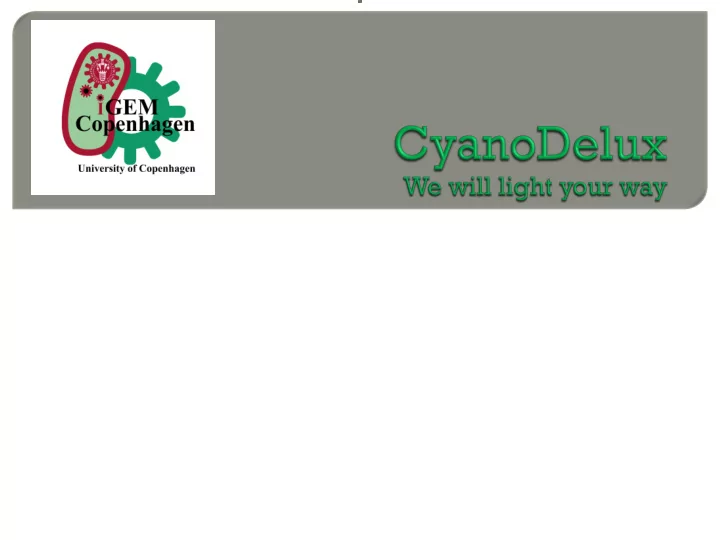

University of Copenhagen iGEM 2012
Copenhagen in numbers: 2463 GWh a year in electricity (2011) 782.000 t CO 2 emitted a year (2011) 550kg CO 2 every year pr. citizen
Circadian Clock – Day-and-night rhythm influences gene expression Performs photosynthesis 6 CO 2 + 6 H 2 O + sun light à C 6 H 12 O 6 + 6 O 2
Night induced promotor lrtA Self-sufficient: Need no nutrient in media CO 2 consuming, sustainable, light source
Bioluminescence Ref (2) Ref (1) The LuxCDABE cassette C D A B E From Photorhabdus luminescens Kindly provided by T. Knight
C Luciferase Reductase FMN Reductase A B E (Fre) Synthetase D Transferase Green light emission: λ 480 E C D A B nm
Expression of luxCDABE under the control of: Strategy 1 : Strategy 2 : A light-regulated A cyanobacterial histidine kinase light-sensitive system promoter
Light Based on the ”pDUSK”-system which has earlier been shown to work in E. coli (3) YF1, FixJ, and FixK2 biobricks kindly provided by Team Uppsala iGEM 2011
Strategy 2: Light-sensitive cyanobacterial promoter lrtA: Cyanobacterial promoter ( Synechocystis sp. PCC 6803) Night: Photosynthesis inactive à lrtA lrtA biobrick kindly turned on provided by team Utah State iGEM 2010
Construct 1: Histidine Construct 2: Cyanobacterial kinase-controlled promoter-controlled luciferase expression luciferase expression
Uracil-Specific Excision Reaction USER Standard assembly Assembly of how many Up to 6 in one go 2 at a time parts? Time? Fast Slow How? Custom-made overhangs Restriction enzymes, ligation Illegal restriction sites? No Yes Scarring? No Yes
Part A Part B A B Target vector
Part A Part B ATCGCAT dU AGGCTTG dU AGGCTTGT AAGCATGCT A B TAGCGTAA dU CCGAACA TCCGAACA dU TCGTACGA ATCGCATT AAGCATGC dU dU AGCGTAA TTCGTACGA Target vector
Part A Part B ATCGCAT AGGCTTG AGGCTTGT AAGCATGCT A B TAGCGTAA CCGAACA TCCGAACA TCGTACGA ATCGCATT AAGCATGC AGCGTAA TTCGTACGA
Part A Part B AGGCTTGT AAGCATGCT A B CCGAACA TAGCGTAA TCCGAACA C G T A C G ATCGCATT A A TTCGTACGA
Part A Part B AGGCTTGT AAGCATGCT A B TAGCGTAA TCCGAACA ATCGCATT TTCGTACGA
ATCGCATT AGGCTTGT AAGCATGCT A B TAGCGTAA TCCGAACA TTCGTACGA
But…..
PCR-Amplification of target genes with appropriate USER ends Direct primer annealing for short regulatory sequences YF1 ProC lrtA Terminator pSB1C3 FixJ FixK2
Biobrick Bba_K770000 : Assembly of ProC, YF1 and pSB1C3 by USER cloning. BBa_K770000
How much CO 2 How much light is is consumed? emitted? How swiftly does the For how long can the system respond to bacteria sustain a high darkness and light? light output? Can the emitted light inhibit the system, creating oscillations? Let’s try to make a mathematical model of the system !
o Biobricks submitted by the DTU 2011 iGEM team o USER assembly was used with succesful results
Two at a time starting with ProC-YF1
DNA pieces have to be equimolar to each other DNA pieces that are different in length do not contain the same number of mol within the same volume.
Large pieces in general are easier to assemble with USER Speculation on trend ProC = 35 bp Smaller pieces have a larger area, in which, by chance, to hit the LrtA = 38 bp correct USER-site YF1 = 1131 bp pSB1C3 = 2070 bp LuxCDABE = 5798 bp
HA more Accessible by smaller DNA A Decreased chance of correct impact Hindered Surface Area Surface Area area (HA) Some possible coil behavior in large B DNA HA non accessible by larger DNA C Increased chance of correct impact
CO 2 consuming, sustainable, light source
REMOVE CO 2 REDUCE ELECTRICITY CONSUMPTION USE We will light your way
Sponsors iGEM teams iGEM Chile iGEM Valencia iGEM Uppsala
(1): en.wikipedia.org/wiki/biolumniscence (2): http://www.pnas.org/content/97/18.cover-expansion (3) Ohlendorf, R., Vidavski, R., Eldar, A., Moffat, K., and Möglich, A. 2012. From dusk till dawn: one-plasmid systems for light-regulated gene expression. J. Mol. Biol. 416:534-42.
External members: Caroline Have – Practical applications Charlotte Varslev-Pedersen – Practical applications Thomas Holst-Hansen – Mathematical models Lea Hansen - Ethics Supervisors Johan Ranberg-Andersen, Peter Naur Lab work performed at: Department of Plant Biology and Biotechnology, Section for Plant Biochemistry Faculty of Life Sciences, University of Copenhagen Parts provided Uppsala University YF1 (BBa_K592004), FixJ (BBa_K592005), FixK2 (BBa_K592006) Thomas Knight luxCDABE gene casette Charles Miller, Utah University lrtA promotor (BBa_K390008) Sponsors Novozymes Novo Nordisk
Recommend
More recommend